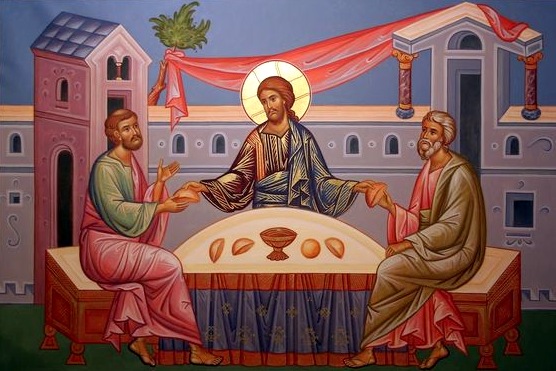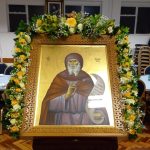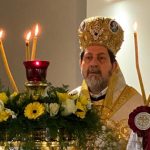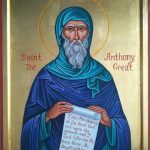The Opening
In peace let us pray to the Lord
The Liturgy, like nearly all Orthodox services, begins with a blessing. This is part of the Old Testament and Jewish heritage of Christianity. To bless, in both Greek and Latin, means ‘to speak well of’, and for us human beings to bless God means to acknowledge our utter dependence on him, to express our gratitude to him, to acknowledge that all we are and have is from him. The Hebrew word for a blessing, berakah, is translated in Greek by both evlogia and efcharistia, and so the whole Liturgy, the Eucharist, is a blessing, a thanksgiving to God. But God also blesses us, above all in the gift of his Son, who became man, brought us the Evangelion, the Good News of salvation and died for us on the Cross and rose in glory on the third day. This is what the Liturgy is all about. So the priest, as he sings the opening blessing, makes the sign of the Cross over the holy Table with the book of the holy Gospel. When there is a deacon he invites the priest to give the blessing with the words ‘Master, give the blessing’. The word ‘Master’, in Greek Despota, reminds both priest and people that the normal celebrant of the Liturgy is the bishop and a simple priest celebrates as the bishop’s representative. The Liturgy is always that of the whole Church, built on the foundation of the Apostles, whose successor the bishop is.
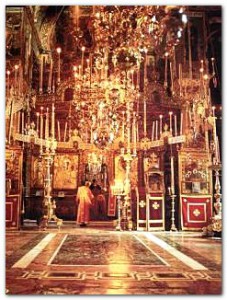
‘Master, give the blessing’
Monastery of Vatopedi
The blessing is followed the first of the litanies, or prayers of supplication, that are a characteristic of Orthodox worship. This litany is often known as the ‘Litany of Peace’, ta Eirenika, because the first three petitions all ask for peace. ‘Peace’, a word which is used some thirty times in the Liturgy, is not simply an absence of conflict. It is to live in harmony with God, with oneself, with all humankind and with the natural world of which we are part. It is above all a gift from God, which, as St Paul writes to the Philippians, ‘is beyond all understanding’. It is the gift that comes with the birth of Jesus, as the angels’ hymn proclaims, ‘Glory to God in the highest, and peace on earth, goodwill among men’. It is how Jesus sends away those he has healed or forgiven, ‘Go in peace’. It is how he greets the Apostles after his resurrection and it is how the bishop and priest greet the people in all the services. ‘Shalom’, in Hebrew, and ’Salaam’, in Arabic, is also the usual greeting among our Jewish and Muslim brothers and sisters.
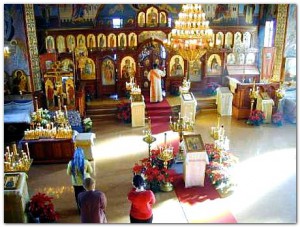
‘In peace let us pray to the Lord’
The Litany of Peace brings before God the whole world, the churches, the local Bishop, the clergy and the whole people of God. We then pray for the civil authorities of the country in which the Liturgy is being celebrated, whether or not they are Orthodox. This has been the practice of the Church since the days of the Apostles. St Paul, in his first letter to Timothy, writes, ‘First of all, then, I ask that supplications, prayers, petitions, and thanksgivings be offered for everyone, for kings and for all in authority, that we may lead a quiet and tranquil life in all devotion and dignity. This is good and pleasing to God our Saviour, who wills everyone to be saved and to come to knowledge of the truth.’
Next we pray not only for the city in which we celebrate the Liturgy, but for all other places and for the believers who live in them. Despite all our technical progress, we are still dependent on nature, on the weather, for our livelihood, and so we pray for ‘favourable weather’ and for a good harvest. Finally we pray for all those in danger and trouble, travellers, the sick and those in prison.
The Church does not only consist of those on earth, it includes all those who have gone before us, and so we associate with our prayer the Mother of God and all the Saints as we ‘entrust ourselves and one another to Christ, our God’. The Litany begins with ‘peace’ and ends with ‘Christ, our God’.
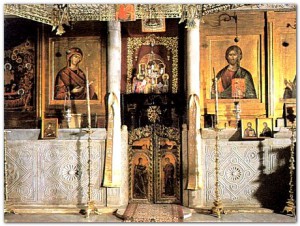
Templon of the Protaton
Mount Athos
The Litany is followed by an ‘Antiphon’, a series of verses each followed by a refrain. In early days the Liturgy began with what we now call the ‘Little Entrance’. In Constantinople the people came in processions, singing psalms, and assembled in the forecourt of the Great Church of Agia Sophia, to await the arrival of the Patriarch and the Emperor. On some occasions they might wait inside the church singing psalms and praying. The Litany of Peace, with the Antiphons and short Litanies that follow, is a survival of the older practice.
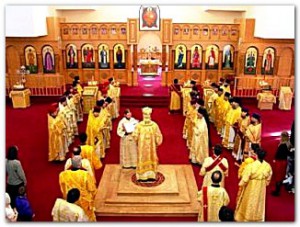
Pontifical Concelebration
The Antiphons
The second Antiphon is followed by a sort on mini-Creed, the hymn ‘Only-begotten Son’, O Monogenes. It is an excellent summary of the essentials of our faith in the Holy Trinity and in the Incarnation, Crucifixion and Resurrection of Christ the Word. It dates from the sixth century and is often attributed to the Emperor Justinian, but may well have been written by Severos of Antioch. Be that as it may, it is well worth learning by heart and it forms a fitting prelude to the solemn Entrance with the book of the Holy Gospel.

